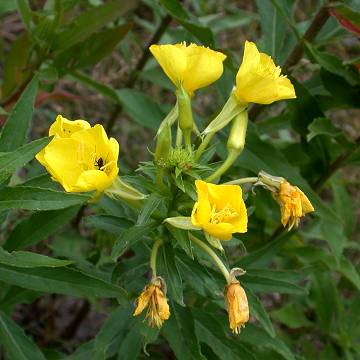

Oenothera biennis - (image 1 of 3)
Taxonomy
Family: Onagraceae
Habitat
Common in weedy fields, on waste ground and on railroad ballast. Also occurs on open sand near Lake Michigan.
Associates
Distribution
Most of the U.S. and southern Canada.
Morphology
Biennial to short-lived perennial, to 2 m high. Leaves alternate, lanceolate to oblong, acute to acuminate, entire to wavy-dentate, sessile or on short-petioles, glabrous to gray-hairy. Flowers 4-merous, in terminal, simple or branched spikes; sepals reflexed, sepal appendages terminal, connivent (touching but not fused) at base; petals yellow, 1-2.5 cm; style mostly less than 2 cm. Fruit thickest near the base; seeds horizontal, angular, not pitted.
Notes
Flowers mid June to early November.
Wetland indicator: Facultative Upland
Members of this genus have a distinctive 4-lobed stigma that forms an x-shape. The roots are edible but require boiling in 2-3 changes of water. Said to have a peppery flavor. Young leaves may also be used.
References
Gleason, Henry A. and A. Cronquist. 1991. Manual of Vascular Plants of Northeastern United States and Adjacent Canada. Second Ed.
The New York Botanical Garden. Bronx, NY
Peterson, L. A. 1977. A Field Guide to Edible Wild Plants: Eastern and central North America.
Houghton Mifflin Company. New York, NY
Swink, F. and G. Wilhelm. 1994. Plants of the Chicago Region.
Indiana Academy of Science. The Morton Arboretum. Lisle, Illinois.
|
Michael Hough © 2005 |